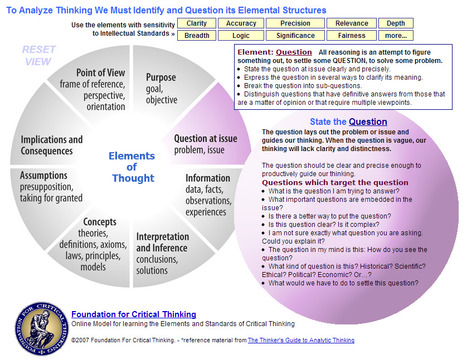If I could ensure that kids come away from science class with one thing only, it wouldn’t be a set of facts. It would be an attitude—something that the late physicist Richard Feynman called “scientific integrity,” the willingness to bend over backward to examine reasons your pet theories about the...
Get Started for FREE
Sign up with Facebook Sign up with X
I don't have a Facebook or a X account
 Your new post is loading... Your new post is loading...
 Your new post is loading... Your new post is loading...
|

Alistair Parker's curator insight,
January 30, 2013 3:57 AM
Beth Dichter's insight: This is a great interactive model of critical thinking. One circle has 8 elements of thought: * Question at issue * Information * Interpretation and influence * Concepts * Assumptions * Implications and Consequences * Point of View As you role over and selelct an element of thought you are hown additional information about the element. For example, if you were to select Point of View you would be prompted to understand your point of view and provided with questions to further your thinking. In addition there are also prompts for intellectual standards to consider. The intellectual standards include: clarity, accuracy, precision, relevance, depth, breadth, logic, significance, and fairness. In each of these area there is a brief definition as well a three additional questions to consider. There is also one choice (more) that provides you with additional standards you might want to consider and suggests that you think of your own. 
R Hollingsworth's curator insight,
January 30, 2013 9:33 AM
I'm thinking this is a pretty complicated model given that many of our very best critical thinking is done within the space of a blink! However, it's useful to be able to break it down and explain it for undergraduates for whom universities have great expectations in criticial thinking but don't really explain how they know what it is when they see it. And, sadly, in introductory courses too often professors don't expect critical thinking of their students - sticking too close to recall or lower levels of application thinking for their expectations of student performance. 
R Hollingsworth's comment,
January 30, 2013 9:34 AM
terrific toy for educators to play with and use - would work great in a group discussion with a faculty scholarly community...
|











Have you heard about the concept of a paradigm shift? This happens when new information comes in that does not fit what we expected. Unfortunately in many cases we choose not to see this lack of fit, and ignore the information. This post looks at this type of issue but suggests that you have students look it as "surprises" and notes that "we need to actively look for signs that our assumptions are wrong..."
How can we do this? Try creating a "Surprise Journal" with your students. Based on one teacher who has done this consider having your students (and you) look for moments of "surprise." Have them respond to two questions:
* Why was this surprising?
* And what does that tell me about myself?
This teacher has collected over 1,000 moments of surprise and shares a few of them in this post.
Here is his statement about how it changed his classroom culture (quoted from the post):
“In the class culture, acknowledgement that you are mistaken about something has become dubbed a ‘moment of surprise’ (followed by a student scrambling to retrieve their journal to record it),” he wrote to me. “As this is much more value-neutral than ‘I screwed up,’ the atmosphere surrounding the topic is less stressful than in previous years.”